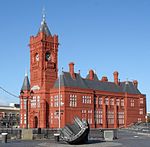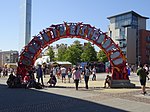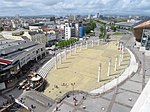Senedd

The Senedd (pronounced [ˈsɛnɛð] (listen); transl. parliament/senate), officially known as the Welsh Parliament in English and Senedd Cymru (Welsh pronunciation: [ˈsɛnɛð ˈkəm.ri]) in Welsh, is the devolved, unicameral legislature of Wales. A democratically elected body, it makes laws for Wales, agrees certain taxes and scrutinises the Welsh Government. It is a bilingual institution, with both Welsh and English being the official languages of its business. From its creation in May 1999 until May 2020, the Senedd was known as the National Assembly for Wales (Welsh: Cynulliad Cenedlaethol Cymru). The Senedd comprises 60 members who are known as Members of the Senedd (Welsh: Aelodau o'r Senedd), abbreviated as "MS" (Welsh: AS). Since 2011, members are elected for a five-year term of office under an additional member system, in which 40 MSs represent smaller geographical divisions known as "constituencies" and are elected by first-past-the-post voting, and 20 MSs represent five "electoral regions" using the D'Hondt method of proportional representation. Typically, the largest party in the Senedd forms the Welsh Government. A National Assembly for Wales was created by the Government of Wales Act 1998, following the result of the 1997 referendum. The Assembly initially had no powers to make primary legislation. Limited law-making powers were gained through the Government of Wales Act 2006. Its primary law-making powers were enhanced following a Yes vote in the referendum on 3 March 2011, meaning that the UK Parliament or the Secretary of State for Wales were no longer consulted when passing acts of the National Assembly for Wales related to the 20 devolved areas. These powers were further extended by the Wales Act 2014 and Wales Act 2017, with the latter moving the Assembly to a reserved powers model of devolution like that of the Scottish Parliament. In May 2020, the Assembly was renamed to "Senedd Cymru" or "the Welsh Parliament" when section 2 of the Senedd and Elections (Wales) Act 2020 came into force. Matters devolved to the Senedd include health, education, economic development, transport, the environment, agriculture, local government and some taxes.
Excerpt from the Wikipedia article Senedd (License: CC BY-SA 3.0, Authors, Images).Senedd
Bute Place, Cardiff Cardiff Bay
Geographical coordinates (GPS) Address Nearby Places Show on map
Geographical coordinates (GPS)
| Latitude | Longitude |
|---|---|
| N 51.465277777778 ° | E -3.1602777777778 ° |
Address
Scott Harbour
Bute Place
CF10 4AA Cardiff, Cardiff Bay
Wales, United Kingdom
Open on Google Maps









